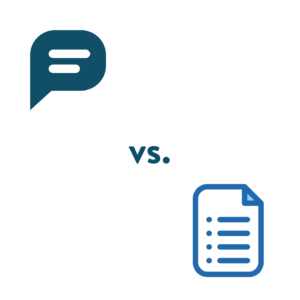Table of Contents
- How Are You Looking to Transform Your Organization Through Feedback and Information?
- Pulse Checks®: Streamlined, Actionable Insights in Real-Time
- Google Forms and Other Long Survey Tools: Quantitative Analysis and Long
- Choosing the Right Fit
- Speed Read: The Difference Between Pulse Checks and Other Surveying Tools
Survey tools play a big role in helping organizations get feedback, understand their community, and make informed decisions.
That said, typical survey tools and Pulse Checks are a bit different. With so many survey platforms (Google Forms, Survey Monkey, Qualtrics, JotForm, TypeForm, Microsoft Forms, you get the picture!🖼️) available, choosing the right one can feel overwhelming. Further, the ability to create a bad survey using existing tools is high.
In this post, we compare two popular methods: Pulse Checks (Possip) and Traditional Surveys (e.g. Google Forms and Survey Monkey). We will look at their features, how easy they are to use, and how well they fit different needs to help you decide which is best for you.
How Are You Looking to Transform Your Organization Through Feedback and Information?
An early consideration is how you might be looking to transform your organization through feedback and information. Ask yourself the following questions:
- Are you looking for a more abstract insight – which might not require action?
- Are you looking to understand what has happened over an extended period of time?
- Or are you looking to make ongoing change?
- Are you looking to constantly know and make decisions?
- Are you looking to truly hear the qualitative experience or is quantitative information sufficient? Does it matter that you’re hearing from your community across race, language, education level, and technology access?
Pulse Checks®: Streamlined, Actionable Insights in Real-Time
Pulse Checks® offer a robust solution for making ongoing change, as you are constantly in the know about what is happening and can use that information as you make decisions. These quick 1-minute check-ins go out in over 100 languages and can drive impact, engage the community, leverage data-driven insights, streamline decision-making, and ensure compliance.
Pulse Checks get real-time perspective to give you a view of your community’s sentiment and feedback. You can stay close to your community’s needs and preferences. Pulse Checks are administered through SMS texting, a hassle-free experience with wide accessibility.
Possip’s Reporting Team translates data into relevant, actionable reports and keeps you and your people central. This empowers you with actionable insights and the ability to respond to needs in the moment or trends over time. Possip emphasizes positive praise, allowing communities to celebrate and highlight exceptional efforts.
On the back end, the data from Pulse Checks and even Strategic Surveys (long-form surveys which Possip also offers) live in one platform where you can compare trends over time, export your data, and filter for key themes that have emerged.
Our new partners at Steele Canyon asked a customized Bonus Question that garnered 300+ responses. When they asked that same question in a Google Form, there were only 50 replies. The accessibility and ease of Possip, among other qualities, made getting the answers easier.
Case Study: Decision Making Made Easy at Steele Canyon Tweet
Google Forms and Other Long Survey Tools: Quantitative Analysis and Long
On the flip side, some people use survey tools like Google Forms or Survey Monkey to conduct online surveys. In fact, before Possip built our technology platform we used those methods too. They allowed our founder to throw a survey together in a low cost way while she was still testing our platform. She found it hard to scale, she had to do a lot of the analysis manually, and it was impossible to easily digest qualitative feedback, an important and rich part of understanding people’s experience.
That said, these survey platforms often boast various features, including customizable themes, question branching, and collaboration options. If you have time to spend building a survey and analyzing the data for a small set, this might be an option.
Survey platforms like Google offer graphs that help users visualize survey results but leave the analysis and meaning-making to you. Google Forms moves its data to Google Sheets, facilitating easy data export for further analysis. It has a palatable price point as well: it’s free.
However, it can be hard to quickly compare data over time with these platforms because the data and analysis is all left to you. So you can really only compare data across respondents without layering on additional analysis. You also don’t get access to trend data (typically), so you only know what your respondents shared and not how their answers compare to similar organizations.
Choosing the Right Fit
There’s a time and place for Pulse Checks, and a time and place for other survey platforms. Even at Possip, we use both!
When deciding between Possip and a platform like Google Forms, consider your specific needs and priorities. If you need a solution and would value one that creates routine, actionable insights, quick turnaround, a place to house your data, the ability to compare over time, scales, and takes the heavy lifting of question creation and analysis off of you, then Possip is likely a good solution.
If you require language translation, Possip offers better accessibility than Google Forms, which does not include this feature. Google Forms and similar platforms are better suited for occasional needs to reach out to smaller groups. However, because these platforms do not offer data analysis or provide actionable solutions by itself, it poses challenges when used for larger groups.
Understanding each platform’s unique strengths and limitations helps you choose the best option for your school.
Speed Read: The Difference Between Pulse Checks and Other Surveying Tools

Ongoing Conversation vs. Deep Dive: Pulse Checks® create quick, ongoing interactions between stakeholders and decision-makers, while other survey tools typically only provide occasional, detailed, number-based insights.
Higher Response Rates: Pulse Checks are frequent and mobile-friendly, leading to higher response rates, as shown by the Steele Canyon case study, which had more responses than Google Forms.
Built for Busy People: Pulse Checks are quick and accessible via SMS, web, and email, with easy reporting. Traditional surveys, though longer, offer more detailed quantitative data. Both for the taker of the survey or pulse check and the analyzer/decision maker, pulse checks are a quicker option.
Designed for Action: Pulse Checks have fewer, open-ended questions. This helps make insights actionable. Platforms like Google Forms are more suited for basic data collection and visualization. They are harder to analyze trends over time, to digest qualitative feedback, and to surface real-time insights.
Built to Scale: Possip’s Pulse Check platform is built to easily scale. The technology was built to digest qualitative feedback easily and quickly, meaning we can digest feedback from 200,000 people over a matter of days.
Quick Turnaround: Because Possip’s AI and technology take on a lot of the heavy lifting, and our team of reporters take on the rest, we’re able to quickly turnaround feedback and insights.



